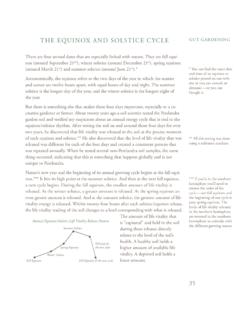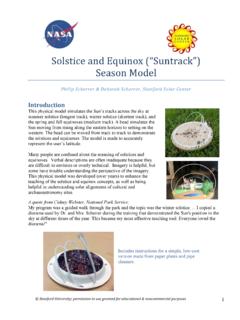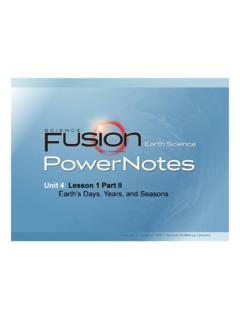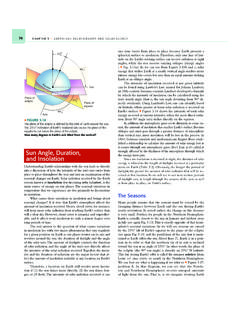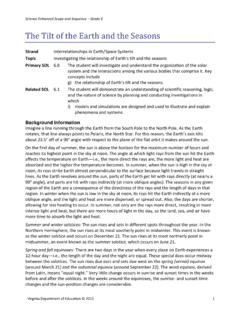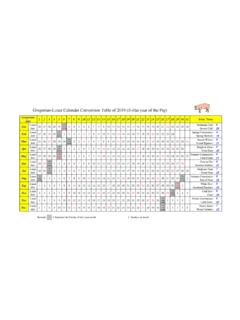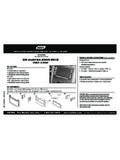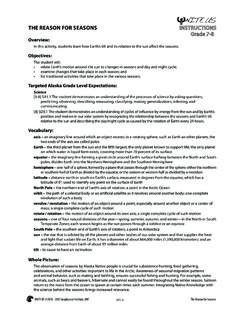Transcription of The Reasons for the Seasons - Marcia's Science Teaching Ideas
1 The Reasons for the Seasons (The Active Learning Approach)Materials: 4 Globes, One light on stand with soft white bulb, 4 flashlights, Four sets of " Seasons " Cards, Four laminated black cards with 1 inch holes in center; also Materials for "Skittles" ONE:1. Place a lamp fixture in the center of your classroom. 2. Tape the electric cord to the floor. 3. Remove the shade and place a large soft white bulb in the lamp. 4. Turn on the lamp and turn off the classroom lights. 5. Have student teams (four is good) hold an Earth globe and walk around the lamp (sun) modeling the orbital path of the Earth.
2 Each team can walk as a team. NOTE: If viewed from above, the Teams walk in a counterclockwise direction! NOTE: Do variations of this, such as; Each Team stands at a different season and the Teams walk around together, shouting the new season as they move into that Have teams place large colored laminated cards on the classroom floor with the dates and names of the spring and fall (autumnal) equinox and the summer and winter solstice. NOTE: Have four sets of different colored cards.
3 Play a speed game. First Team done placing cards at the appropriate spots gets the 4 points, second done - 3, : Be sure teams do not change the orientation of the axis while orbiting the model sun. 7. Quiz Teams on various aspects of this set-up, such as: What Season are you at now, Team One? How do you know? Are we closer or farther away for this season?What season is the Southern Hemisphere experiencing now?How do you know?At what angle is the Earth pointing toward the Sun?What is the Special Day called?
4 Date of that Day? Copyright 2003 - 2004. M. J. Krech. All rights reserved. Reproduction for educational purposes is TWO:7. Now, turn off the lamp and have the Teams turn on the flashlights, which now represent the Sun. 8. The Teams hold the globe 3 feet away from the flashlight and place the black laminated card with the one inch hole between them. 9. Adjust the distances so the flashlight shines a one inch beam of light on the equator. Have the Teams measure the size of the beam of light on the globe to be sure.
5 [The shape should be a perfect circle - 1 inch across.] This is called Direct Slowly tilt both the flashlight and cardboard to move the light beam away from the equator toward the Tropic of Cancer or Capricorn, being careful not to change their relative positions. Have students measure the size of the light beam as it moves north or south. [The shape should be an oval, larger than 1 inch across.] This is called Indirect While the new location receives the same amount of light (solar energy), what happens to the light s size and shape, and thus Intensity as it moves away from the equator?
6 [It increases in size, thus decreasing the amount of solar energy in any one area.]Where on the globe is the light beam most intense?What is the shape of this area?What causes this?Where on the globe is the light beam least intense?What is the shape of this area?What causes this?ACTIVITY THREE:12. Do the Angle of Sunlight Lab with Jellybeans, Skittles, or dried FOUR:13. Cut & Paste "What Season is This?" WorksheetACTIVITY FIVE:14. Label the Seasons Worksheet - Use one from your textbook series.
7 The more "traditional" type. More likely to be on a state assessments can probably do it now! Copyright 2003 - 2004. M. J. Krech. All rights reserved. Reproduction for educational purposes is encouraged. WINTERSUMMERSPRINGFALL Copyright 2003 - 2004. M. J. Krech. All rights reserved. Reproduction for educational purposes is 22 MARCH 21 JUNE 21 SEPTEMBER 22 Copyright 2003 - 2004. M. J. Krech. All rights reserved. Reproduction for educational purposes is EQUINOXAUTUMNAL EQUINOXSUMMER SOLSTICEWINTER SOLSTICE Copyright 2003 - 2004.
8 M. J. Krech. All rights reserved. Reproduction for educational purposes is OF SUNLIGHT LAB Name_____ Class_____ Directions:1. Shine the flashlight directly at the grid on this page, at right angles, from a height of about 15 cm. Trace the lighted area with a pencil. Label #1. 2. Change the angle of the flashlight to about 30o. Hold the flashlight at about 15 cm above the paper. Trace the area. Label #2. Observations:1a:Number + Half the Number = Approximate Areaof full blocksof Partial Blocks _____ +_____ = _____ 1b:Number of Beans X 40 oC / Approx.
9 Area = Temp. of One Block oC (from Step 1a) _____ X 40 oC * / _____ = _____ oC (*The amount of heat absorbed by one "bean.")2a:Number + Half the Number = Approximate Areaof full blocksof Partial Blocks _____ +_____ = _____ 2b:Number of Beans X 40 oC / Approx. Area = Temp. of One Block oC (from Step 2a) _____ X 40 oC * / _____ = _____ oC Copyright 2003 - 2004. M. J. Krech. All rights reserved. Reproduction for educational purposes is OF SUNLIGHT Summary Questions:1.
10 If the flashlight were sunlight, which angle would heat the paper the most?2. In general, where would the world have higher temperatures? Why?3. Refer to a world map and list at least 6 different countries you think would have the highest temperatures on the If the flashlight were sunlight, which angle would heat the paper the least?5. In general, where would the world have lower temperatures? Why?6. Refer to a world map and list at least 6 difference countries you think would have the coldest temperatures on the planet:7.

